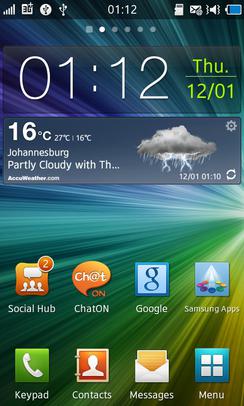 | |
 Bada 2.0 home screen | |
| Developer | Samsung Electronics |
|---|---|
| Written in | C++[1] |
| OS family | Linux |
| Working state | Discontinued (replaced by Tizen) |
| Source model | Mixed: proprietary and open source components |
| Final release | 2.0.6 SDK / 28 February 2013 |
| Marketing target | Smartphone |
| Available in | Multilingual |
| Package manager | Samsung Kies |
| Kernel type | Monolithic (Linux Kernel) |
| Default user interface | TouchWiz, graphical (touchscreen) |
| License | Proprietary |
| Official website | www |
| Bada | |
| Hangul | 바다 |
|---|---|
| Revised Romanization | Bada |
| McCune–Reischauer | Pada |
Bada (stylized as bada; Korean: 바다) was a mobile operating system developed by Samsung Electronics for devices such as mid- to high-end smartphones[3] and tablet computers. The name is derived from "바다 (bada)", meaning "ocean" or "sea" in Korean. All phones running Bada were branded with the name Wave, unlike Samsung's Android devices which are branded as Galaxy.[citation needed]
Bada is based on Mentor Graphics' Nucleus RTOS kernel[4] or Linux kernel, and was planned to become as middleware separated from an OS kernel, but development was discontinued. To foster adoption of Bada, Samsung reportedly considered releasing the source code under an open-source license, and expanding device support to include Smart TVs.[5]
In June 2012 Samsung announced its intention to merge Bada into the Tizen project,[6][7] while still using it in parallel with Google's Android OS and Microsoft's Windows Phone on its smartphones. On 25 February 2013, Samsung announced that it would stop developing Bada, moving development to Tizen instead.[8][9] Bug reporting was terminated in April 2014.[10]
- ^ Lextrait, Vincent (January 2010). "The Programming Languages Beacon" (10.0 ed.). Archived from the original on May 30, 2012. Retrieved January 5, 2010.
- ^ Cite error: The named reference
badaArchitectureKernelwas invoked but never defined (see the help page). - ^ Johnson, Maxime (July 2010). "Bada: un système d'exploitation pour les cellulaires Samsung" (in French). Archived from the original on July 13, 2010. Retrieved July 7, 2010.
- ^ Samsung Electronics' strategy to compete in the 'bada' is..., Bloter, 2009.11.18, https://www.bloter.net/news/articleView.html?idxno=7334
- ^ "Samsung to Make Bada OS Open Source and Part of Your Smart TV". Tech crunch. September 20, 2011. Retrieved September 20, 2011.
- ^ "Samsung to merge Bada with Tizen: the OS party just got a little freaky", Engadget, January 14, 2012, retrieved June 24, 2012
- ^ Woyke, Elizabeth (January 13, 2012). "Samsung Merging Its Bada OS With Intel-Backed Tizen Project". Forbes.
- ^ Samsung scraps Bada OS, folds it into Tizen - FierceMobileIT Archived February 28, 2013, at the Wayback Machine. Fiercemobilecontent.com (2013-02-25). Retrieved on 2013-12-09.
- ^ Linn, Kenneth (August 28, 2012). "Samsung vs Apple verdict may influence Google & Tizen". Archived from the original on August 26, 2014. Retrieved August 22, 2014.
- ^ bada Master (April 9, 2014). "End of bada bug reporting notice". Archived from the original on August 26, 2014.